Rocky shore ecosystem illustration
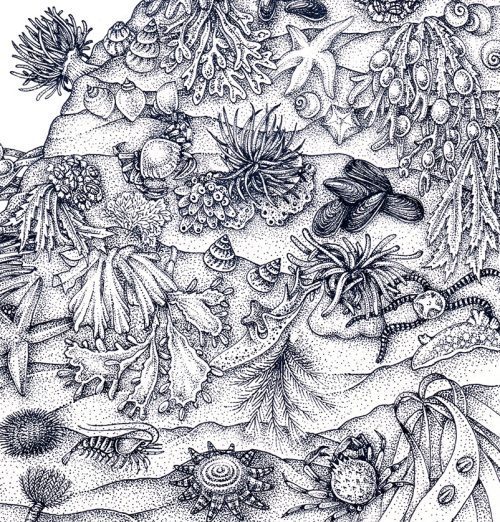
Rocky shore ecosystem: a lucky break
I recently illustrated The Hidden Universe by Alexandre Antonelli. This image of the zonation of a rocky shore ecosystem was one of the illustrations.
The timing of this illustration was an extraordinary stroke of luck. Alex wanted a drawing that shows the different animals and seaweeds on rocky shores. These plants and animals grow in different zones going up the shoreline. The factors that cause these differences (also known as zonation) include physical forces such as salt levels, dehydration, physical damage from the waves. There are also biological, or biotic factors at play, such as predation, competition for food, and competition for space.
How do I know? Well, the week I started this project, I went on a fabulous weekend course. All about Discovering life on rocky shores! The course is hands on, so I took tons of photos and copious notes. I sketched barnacle speciation, and shrieked with delight at Porcelain crabs. I even saw my first blue-ray limpet.
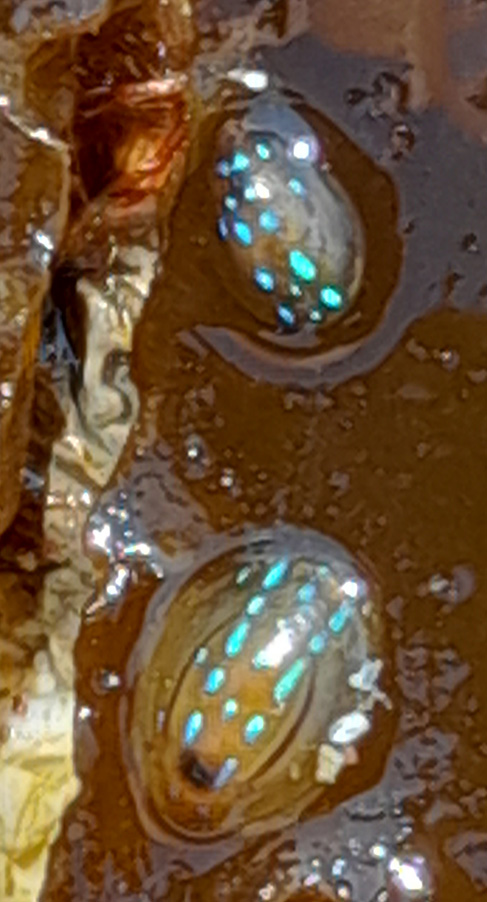
My very poor photo of Blue-ray limpets
So when this illustration turned up, I was exceptionally well equipped. Here’s the pencil rough, which I annotated so that it made a bit more sense.
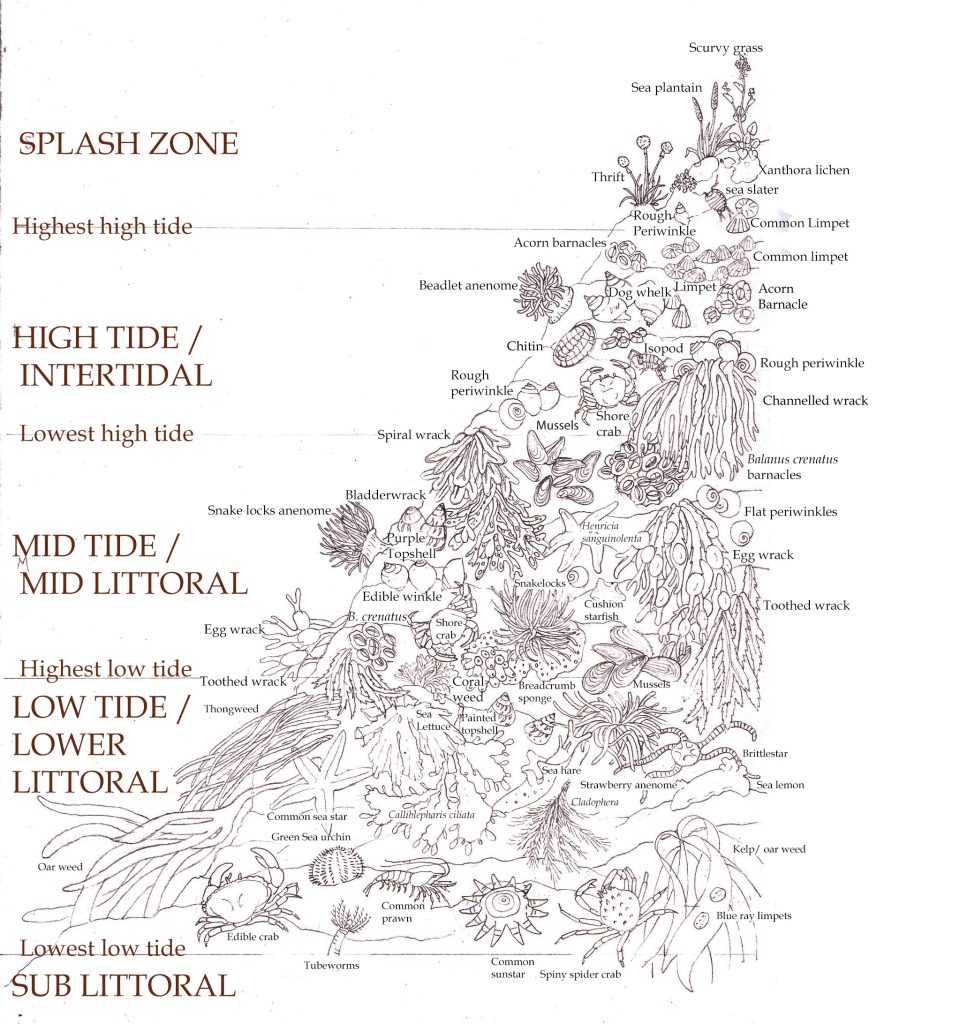
Annotated rocky shores illustration
And here’s the final illustration. Inking it up was an absolute joy, although it took a great deal longer than I would have liked!
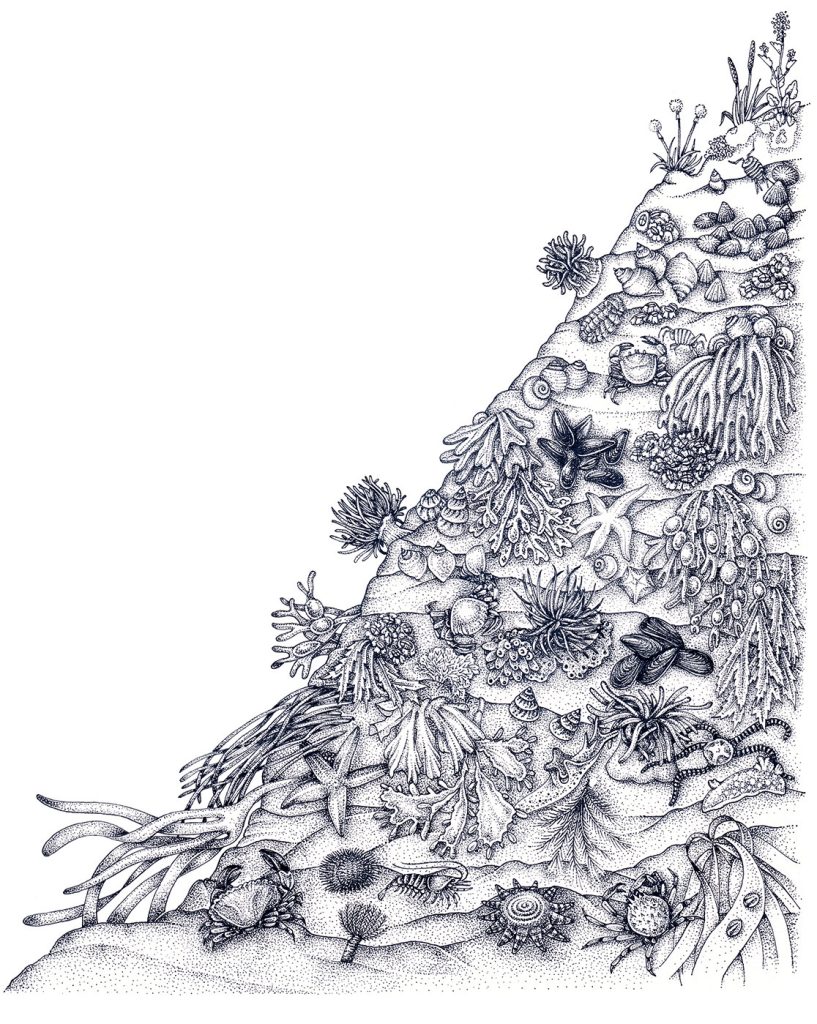
Rocky shore line ecosystem zonation of species
In this blog, there are so many animals and plants discussed, that I’m taking the decision not to give every scientific name. It’s just be a jumble of italicised Latin if I did. Apologies in advance to the purists among you!
Rocky shores: Splash zone
The very top of a shore is known as the splash zone.
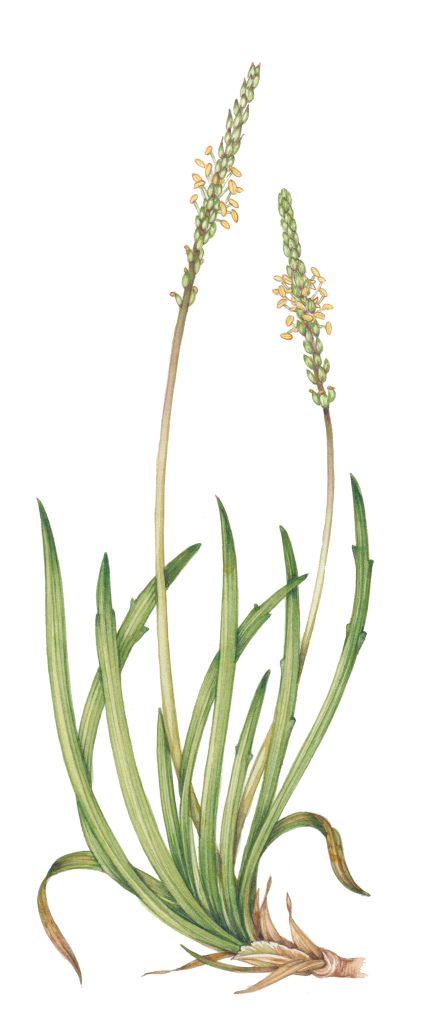
Sea plantain Plantago maritima
The top zone has very little growing there except for the odd brave plant and Xanthora lichen. you might get tough periwinkles, but the combination of dry and salty splashing is lethal to most organisms.
Plants that do survive here have amazing adaptations to allow them to tackle the salt. They’re known as Halophytes, and I wrote a blog on them a while back.
Animal wise, shore flies visit, and slaters (relatives of woodlice) crawl about. You get limpets, clinging on and anchoring themselves to the exact same spot for most of their lives.
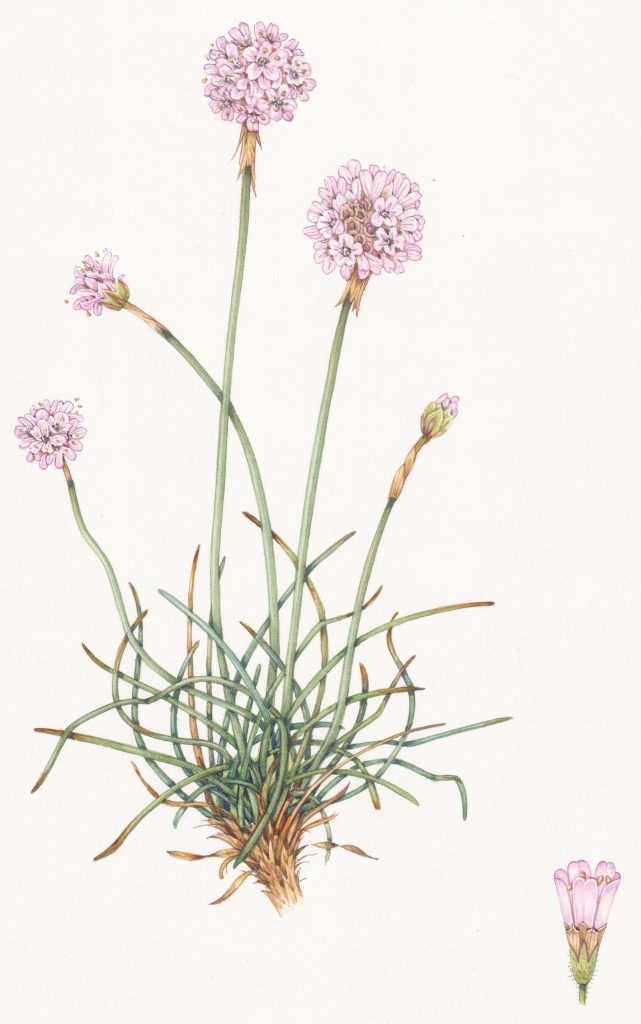
Thrift Armeria maritima
Rocky shore Intertidal zone
Lower down, you’ve got the high tide or intertidal zone. Animals and plants living here have to handle massive fluctuations in temperature and being out of water for 12 plus hours every day. the crashing waves cause physical damage. On the plus side, it’s so hard to survive here that there’s not a lot of competition.
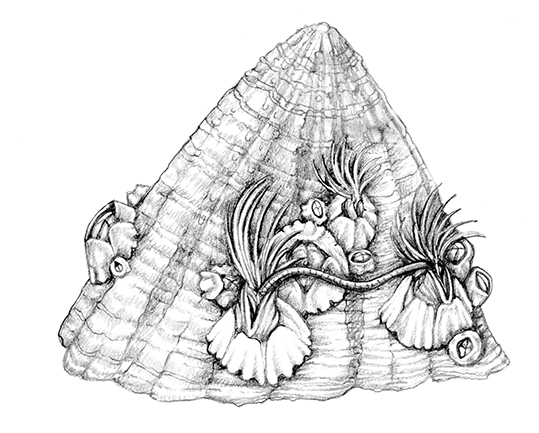
Limpet (with mating barnacles on the side)
Chitons, whelks, winkles, and barnacles live here alongside hardy sea anemones and the toughest of all seaweeds, channelled wrack.
The whelks travel around when the tide is in, predating on mussels and other bivalves by drilling a hole through their shells and sucking out the meat.
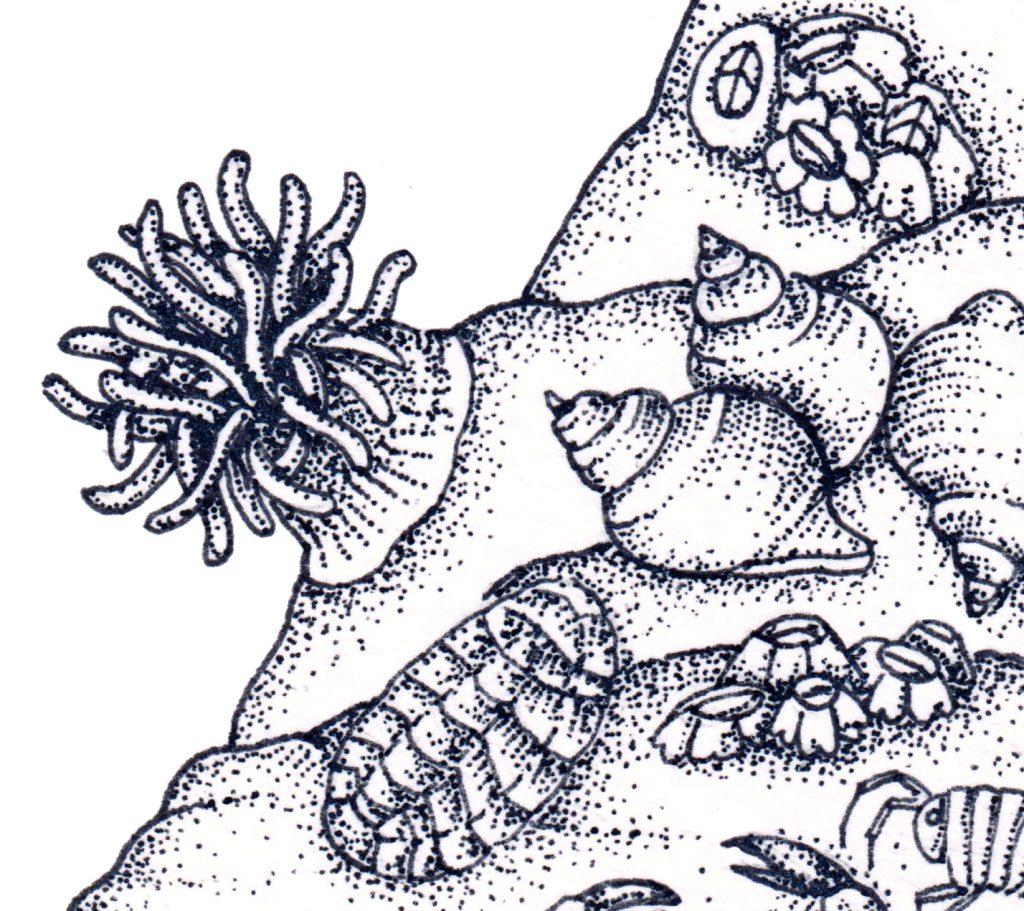
Detail of the intertidal showing chitons, whelks, and a sea anemone
Rocky shore Mid tidal
This stretch is exposed for shorter times between tides. There’s less wave action as a lot of the time the area is submerged. You need to handle the changes in temperature and salt, but it’s a less extreme environment than the upper tidal or splash zone.
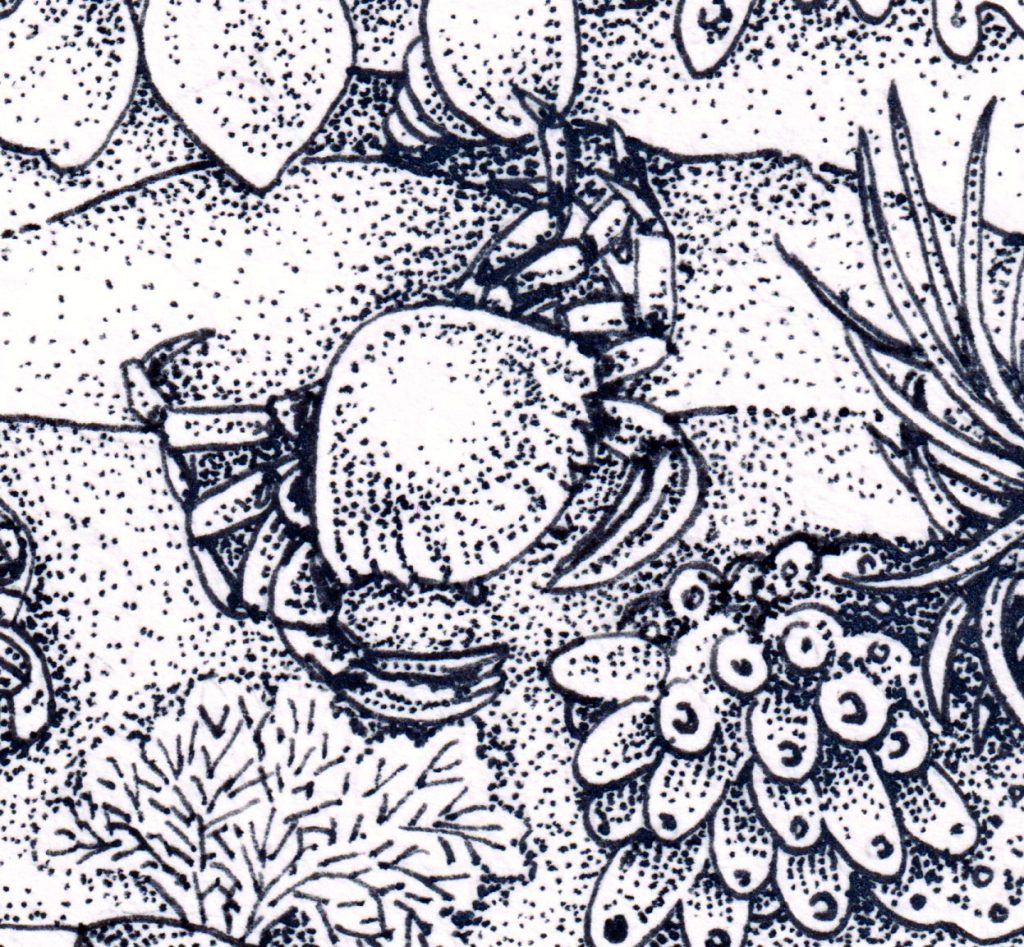
Mid tidal zone: Crab and Breadcrumb sponge with coral weed
More animals and plants live here. Tons of shells like top-shells, barnacles, Perwinkles, and mussels, hang out amidst the seaweeds. Different species of top shell and winkle favour different areas of the rocky shore.
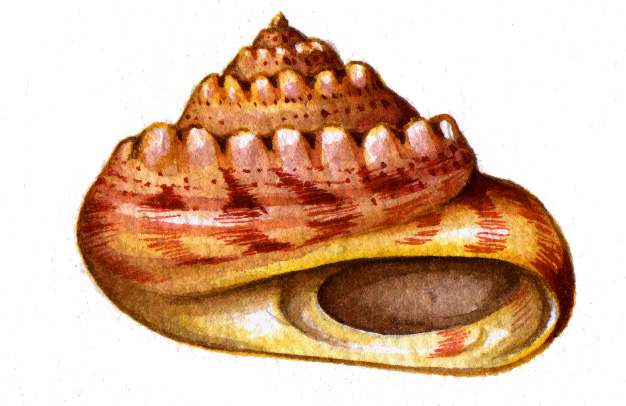
Topshell
You can tell Periwinkle and Top-shell species apart by the shape of their operculum, the door at the bottom of their shells. In top-shells this is invariably round. Periwinkle operculum are tear shaped.
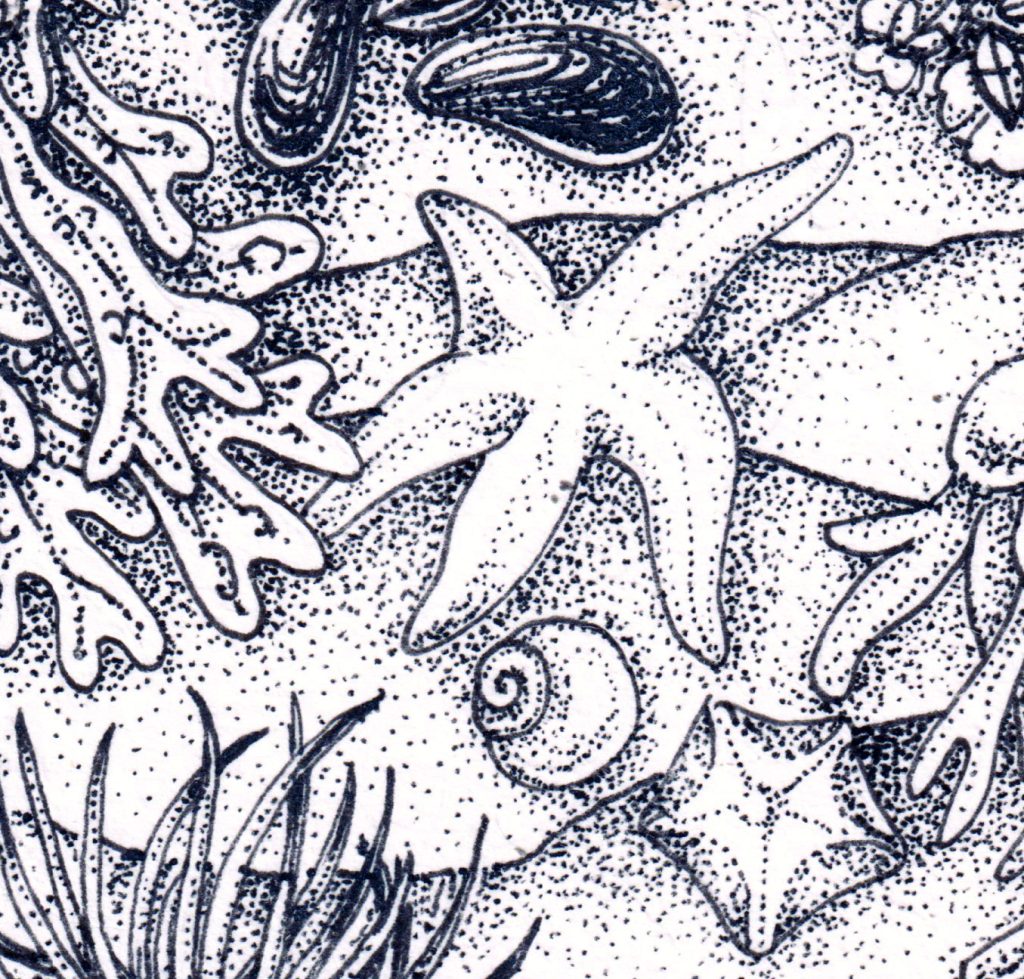
Detail of the mid tidal: Smooth periwinkle, Pin cushion starfish, mussels and bladderwrack
There are more sea anemones, and visiting shore crabs. Sponges and starfish abound.
The drawback is that there are more animals surviving here, so there’s more competition for space. Predation kicks in too, with the starfish feeding on mussels, flat periwinkles chewing seaweeds, and whelks feeding on bi-vales. These are the biotic factors starting to kick in.
If space does become free, it’ll quickly be re-colonised.
Rocky shore Mid tidal: Barnacles
Barnacles have a good system; they can grow on top of other shellfish, and can extend their filtering arms from this substrate. Barnacles are actually crustaceans, related to crabs and shrimp.
Free living barnacle larva land on intertidal rocks where their heads split and they establish themselves for a stationary life. They filter food particles form the sea with their legs, which are adapted to work as sieves.
The problem with living on a shellfish is that if and when that shell dies, you get plunged to the floor where it’s every likely you will die.
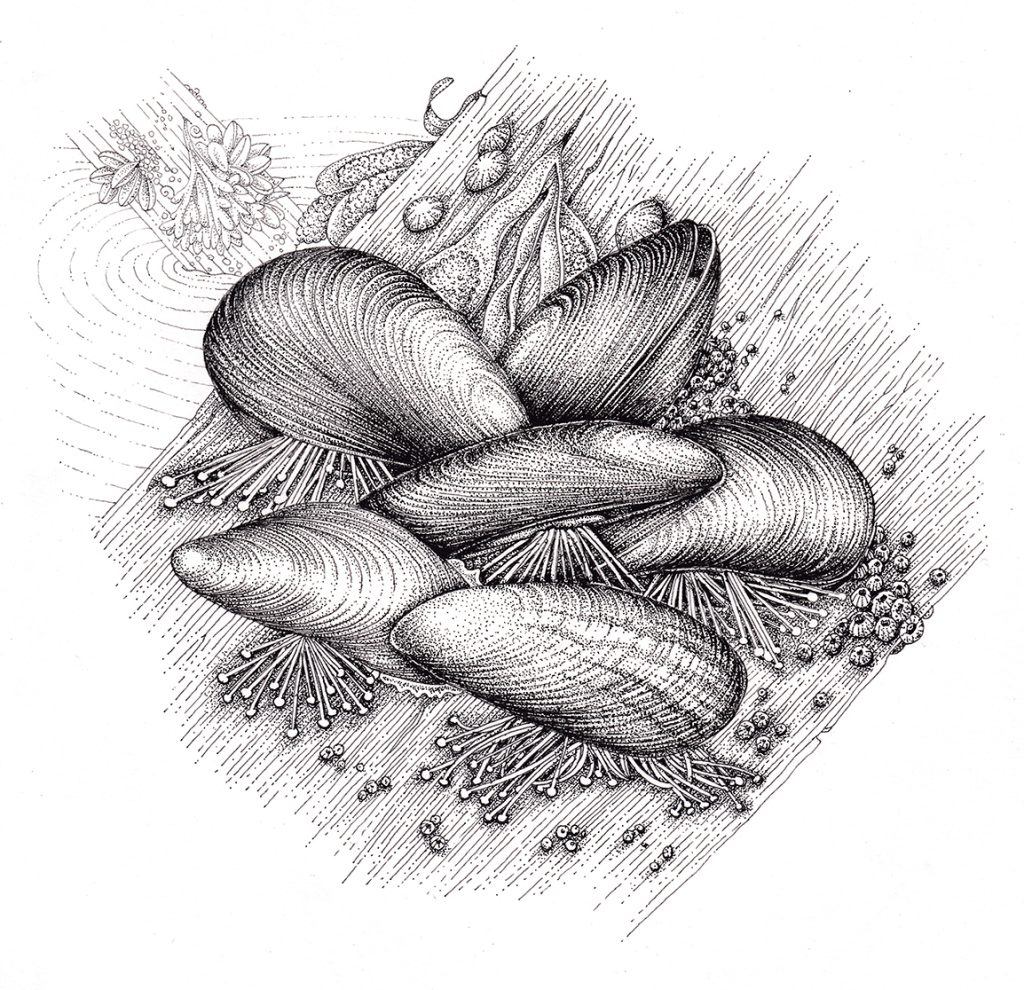
Blue mussels Mytilus edulis with barnacles and bladder wrack
Rocky shore Mid tidal: Seaweeds
Seaweeds thriving in the mid-tidal zone are bladder-wrack, egg-wrack, toothed wrack, spiral wrack. These grow at very specific heights along the shore, depending on their adaptations and tolerance to heat and dry conditions.
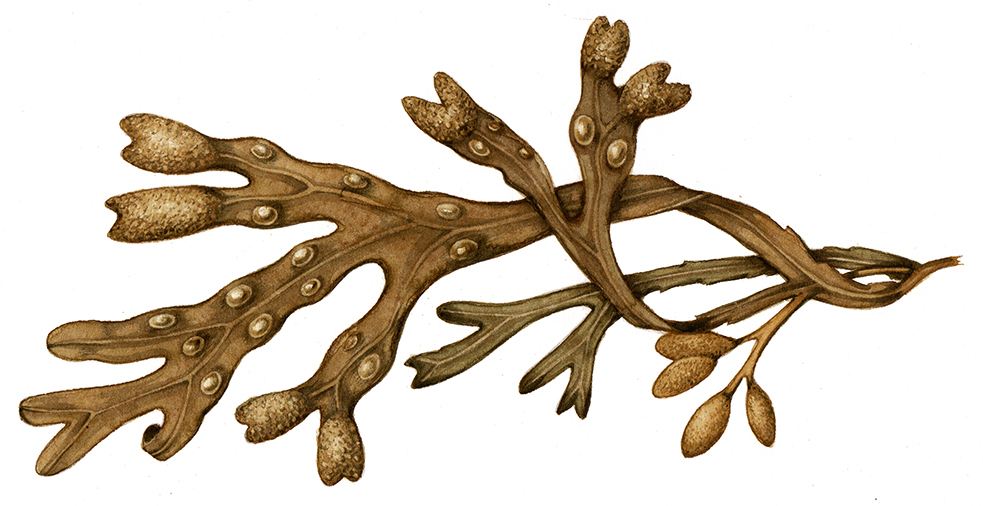
Bladderwrack Fucus versicolor
Rocky shore Lower tidal zone: Species
The lower tidal zone is altogether more comfortable. Exposure to air, desiccation and the heat of the sun is far less frequent. In fact, it only happens at low tides. The waves are less problematic.
The bladder wracks give way to kelp. Brown algal wracks are unpalatable to most animals. In the UK, it’s only the Flat periwinkle that can handle eating it. Oar weed and sugar kelp are an entirely different prospect and are clearly much easier to eat. If you are lucky and look closely at low tide, you might see the tiny and stunning Blue-ray limpets grazing on a blade of Oar weed.
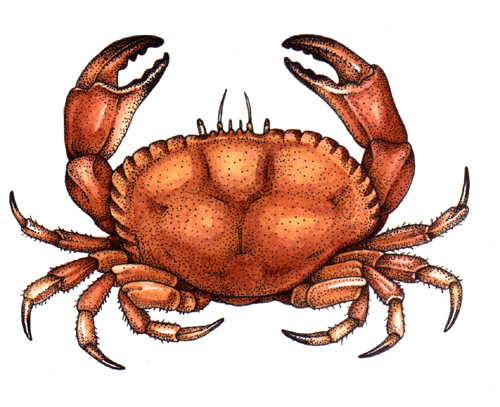
Edible crab, sea urchins, tube worms, star fish, brittle stars, more sea anemones, sea lemons and nudibranch hang out here, along with bivalves.
You also see Porcelain crab with their strange, squashed bodies. Decorator crab, often festooned with bits of seaweed can be seen too. Hermit crabs spend much of their time in this zone.
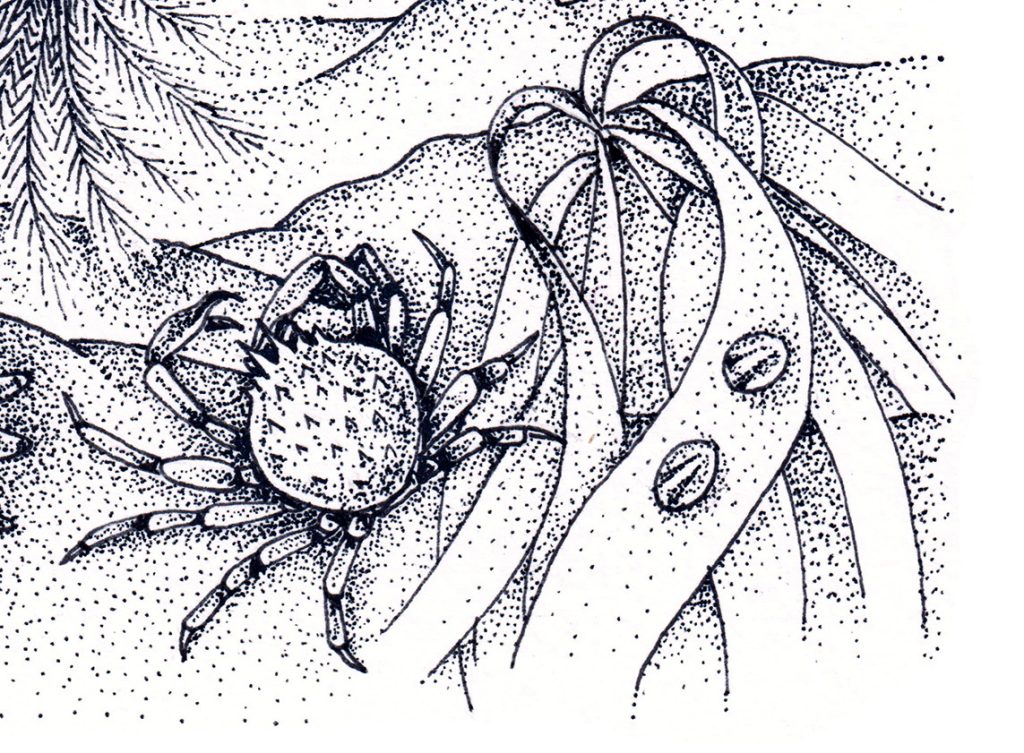
Lower tidal zone: Spiny Decorator crab, Sugar kelp, and blue ray limpets
Rocky shore Lower tidal zone: Biotic factors
Flip side? Biotic (rather than physical) factors. Far more predation. And intense competition for space and things to eat. Of course, with the physical factors being so much easier to handle, many organisms will migrate from this zone to the Mid tidal once the sea covers them. There they can eat and predate on other species before retuning to the safety of the lower shore before the tide exposes them again.
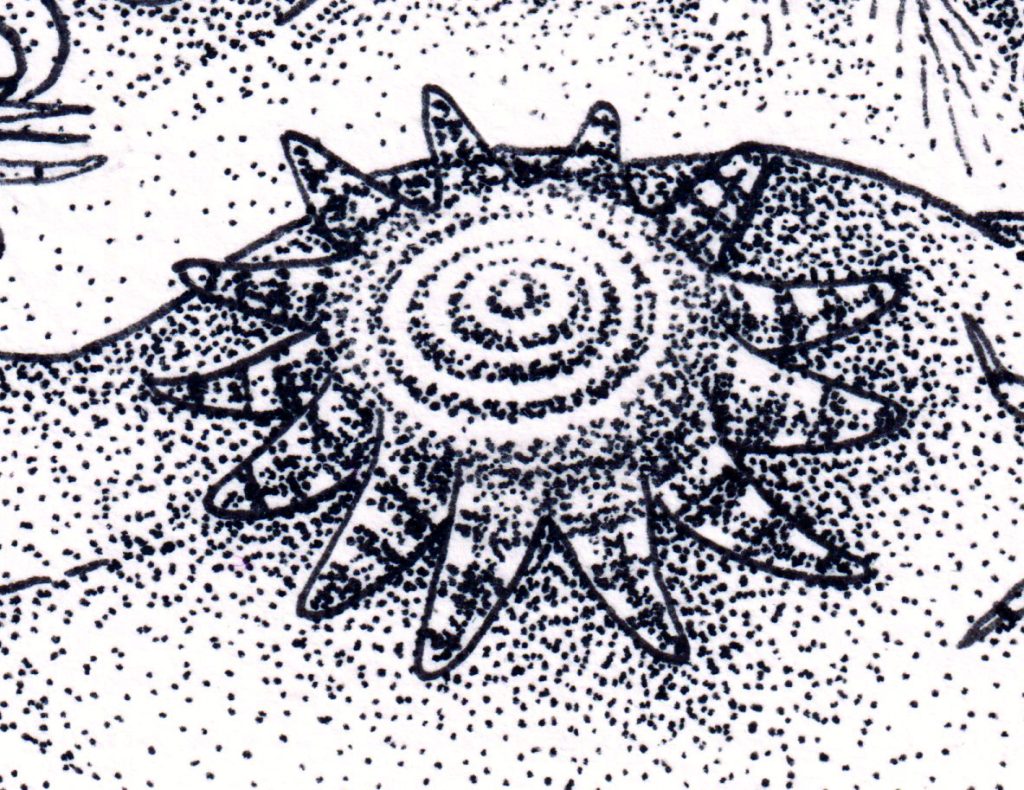
Rocky shore Lower tidal zone
You even get sun-stars.
The biological factors such as predation and competition are extreme here. Predation is fierce. And competition for space in intense. Yes, you don’t get smashed up by waves or dried out twelve hours a day. But you do get eaten, and may well find it impossible to get a foothold in such a heavily populated zone.
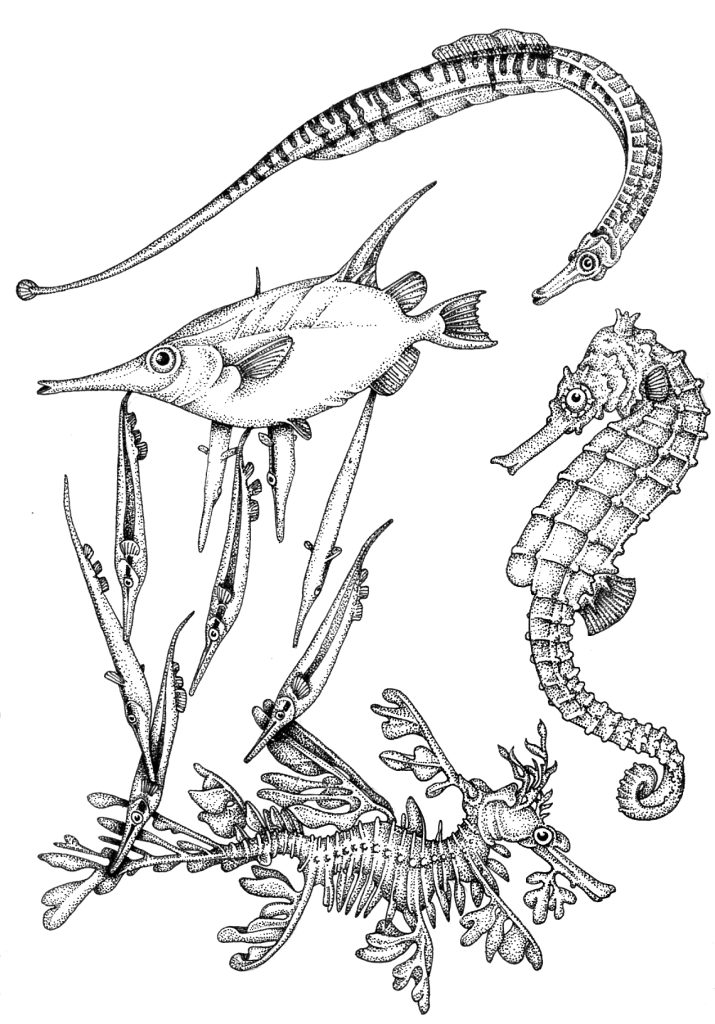
Seahorse family groups
Some seahorse and pipefish species will spend time in this zone, although drying out is a real problem for them, so they tend to stay in the sub littoral.
Rocky shore: Sub littoral
Below the lower tidal zone is the sub littoral. This area of the shore is never exposed to the air, not even at the lowest of tides. It tends not to figure in rocky shore zonation as it’s more like shallow ocean than the shore. Fish, crabs, lobster, kelp forests all abound here.

American lobster Homarus americanus
Complicating factors: Rockpools
Rockpools are vital for lots of these organisms, although they can suffer from enormous halinity and temperature fluctuations. But to the aspiring rocky shore ecologist, rock pools can be confusing, As they remain wet, you get organisms living there that should not be seen in the Upper tidal zone, or mid tidal areas of the beach. Luckily, this is catered for by ecologists who examine rock pool life as a subset of the larger ecosystem.
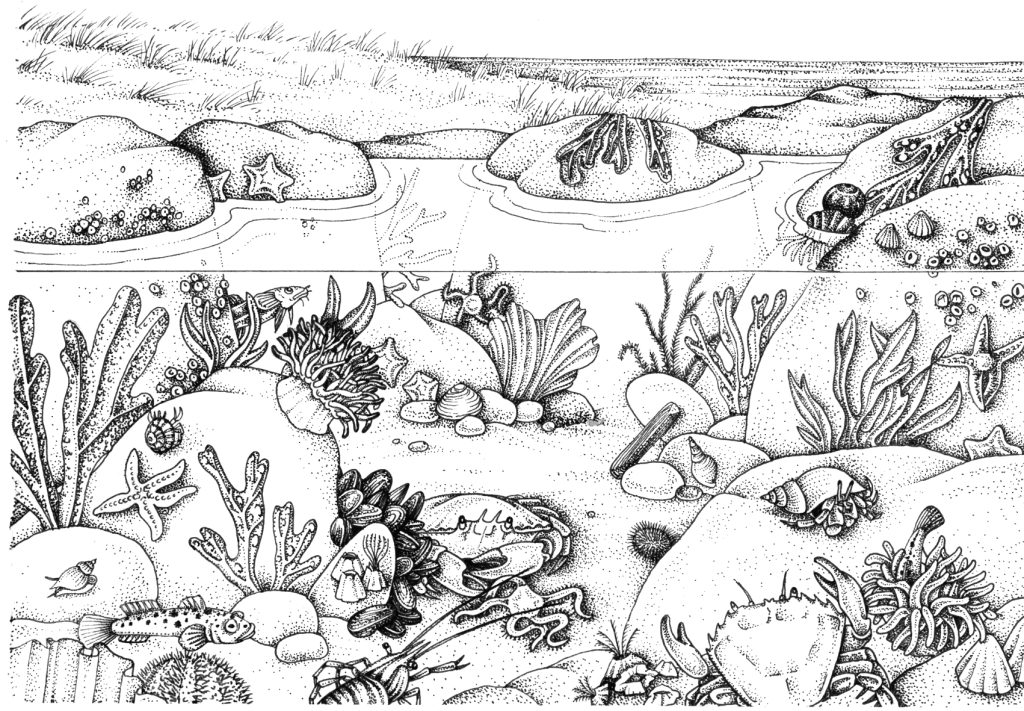
The illustration above was done many years ago. I now know that brittlestar (lower littoral specialists) and razor clams (sand living specialists) are unlikely to appear in any European rockpool. You live and you learn.
Complicating factors: Exposure
It should also be remembered that the exposure of a rocky shoreline will have an enormous effect on the life there. High exposure means it’s even harder to exist in the splash zone and Upper tidal. More sheltered shores offer an easier existence.
Conclusion
This is truly a whistle-stop tour of the zonation of the rocky shoreline. I have no doubt this blog is peppered with mistakes. The FSC course tutor, John Archer Thompson probably has his head in his hands as he reads my version of his wonderful teaching.
As an excellent launch pad to much more on this subject, thanks to John, please check out his FSC rocky shore pages.
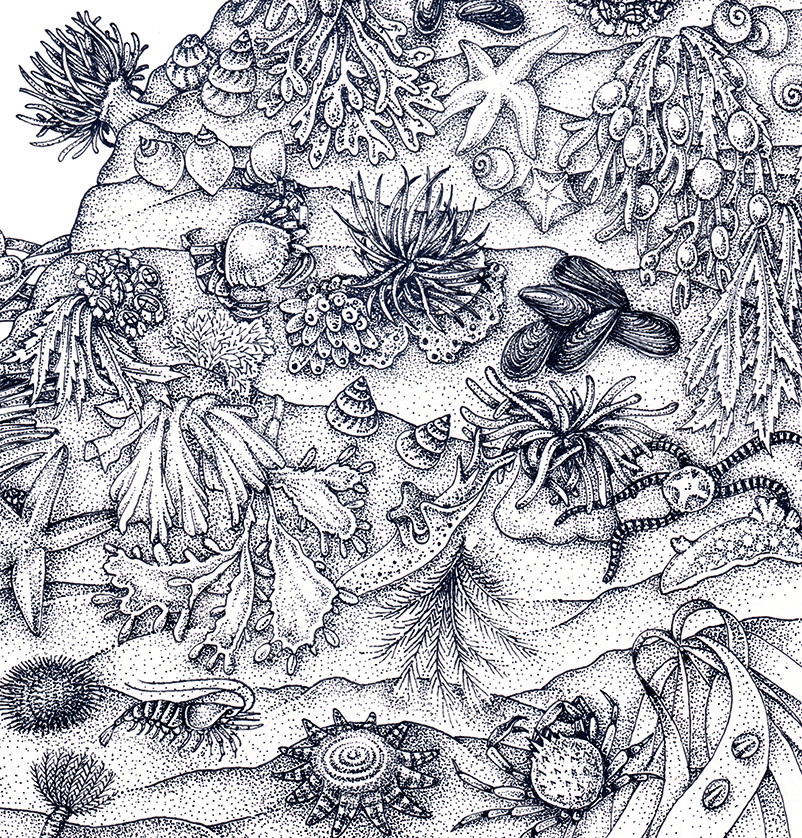


Hi Lizzie, an interesting lesson on this subject and one I know only alittle about.
Thank you so much for this.
Regards Peter
Glad it was of interest, Peter!
Very interesting and fantastic drawings
Thank you Pamela, what a lovely comment